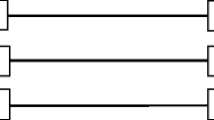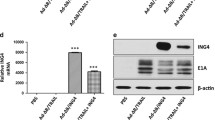Abstract
Methods
We applied an experimental approach employing two recombinant adenoviral vectors (Ad) that express interleukin-12 (IL-12) and angiostatin-like molecule (K1-3) respectively to a subcutaneous hepatoma model in mice.
Results
Injection of AdK1-3 into tumour nodules established by subcutaneous (s.c.) implantation of Hepa129 hepatoma cells in C3H mice resulted in a significant dose-dependent reduction in tumour growth by 57% in the high dosage group (5×109 plaque-forming units [pfu], n=8) 10 days after treatment initiation. Similar antitumoural effects were found for the intratumoural mono-therapy with IL-12 (2.5×109 pfu, n=8) resulting in 60% tumour inhibition at the same time point. The survival rate was significantly (p=0.009) improved in the IL-12 but not in the K1-3 treatment group. A combination therapy of AdK1-3 and AdIL-12 was also effective, but did not further improve antitumour efficacy compared with the monotherapy.
Conclusion
In conclusion, both mono- and combination therapy of K1-3 and IL-12 significantly inhibited tumour progression in this experimental tumour model. The co-administration of both compounds did not result in additive antitumour effects. We hypothesise that the lack of additive antitumour effects of the combination treatment might be attributed to partially counteracting antitumour effects and further studies are needed to illustrate the interference of tumour angiogenesis and tumour inflammation in this tumour model.






Similar content being viewed by others
References
Lau WY (2000) Primary liver tumors. Semin Surg Oncol 19:135–144
Lau WY, Leung TW, Yu SC, Ho SK (2003) Percutaneous local ablative therapy for hepatocellular carcinoma: a review and look into the future. Ann Surg 237:171–179
Yu AS, Keeffe EB (2003) Management of hepatocellular carcinoma. Rev Gastroenterol Disord 3:8–24
Okuda K (2000) Hepatocellular carcinoma. J Hepatol 32:225–237
Mazzolini G, Prieto J, Melero I (2003) Gene therapy of cancer with interleukin-12. Curr Pharm Des 9:1981–1991
Prieto J, Herraiz M, Sangro B, Qian C, Mazzolini G, Melero I et al (2003) The promise of gene therapy in gastrointestinal and liver diseases. Gut 52 [Suppl 2]:ii49–ii54
Trinchieri G (2003) Interleukin-12 and the regulation of innate resistance and adaptive immunity. Nat Rev Immunol 3:133–146
Voest EE, Kenyon BM, O’Reilly MS, Truitt G, D’Amato RJ, Folkman J (1995) Inhibition of angiogenesis in vivo by interleukin 12. J Natl Cancer Inst 87:581–586
Barajas M, Mazzolini G, Genove G, Bilbao R, Narvaiza I, Schmitz V et al (2001) Gene therapy of orthotopic hepatocellular carcinoma in rats using adenovirus coding for interleukin 12. Hepatology 33:52–61
O’Reilly MS, Holmgren L, Shing Y, Chen C, Rosenthal RA, Cao Y et al (1994) Angiostatin: a circulating endothelial cell inhibitor that suppresses angiogenesis and tumor growth. Cold Spring Harb Symp Quant Biol 59:471–482
Ishikawa H, Nakao K, Matsumoto K, Ichikawa T, Hamasaki K, Nakata K et al (2003) Antiangiogenic gene therapy for hepatocellular carcinoma using angiostatin gene. Hepatology 37:696–704
Schmitz V, Wang L, Barajas M, Gomar C, Prieto J, Qian C (2004) Treatment of colorectal and hepatocellular carcinomas by adenoviral mediated gene transfer of endostatin and angiostatin-like molecule in mice. Gut 53:561–567
Schmitz V, Wang L, Barajas M, Peng D, Prieto J, Qian C (2002) A novel strategy for the generation of angiostatic kringle regions from a precursor derived from plasminogen. Gene Ther 9:1600–1606
Gyorffy S, Palmer K, Podor TJ, Hitt M, Gauldie J (2001) Combined treatment of a murine breast cancer model with type 5 adenovirus vectors expressing murine angiostatin and IL-12: a role for combined anti-angiogenesis and immunotherapy. J Immunol 166:6212–6217
Wilczynska U, Kucharska A, Szary J, Szala S (2001) Combined delivery of an antiangiogenic protein (angiostatin) and an immunomodulatory gene (interleukin-12) in the treatment of murine cancer. Acta Biochim Pol 48:1077–1084
Mazzolini G, Qian C, Xie X, Sun Y, Lasarte JJ, Drozdzik M et al (1999) Regression of colon cancer and induction of antitumor immunity by intratumoral injection of adenovirus expressing interleukin-12. Cancer Gene Ther 6:514–522
Coussens LM, Werb Z (2001) Inflammatory cells and cancer: think different! J Exp Med 193:F23–F26
Qin LX, Tang ZY (2002) The prognostic molecular markers in hepatocellular carcinoma. World J Gastroenterol 8:385–392
Park YN, Kim YB, Yang KM, Park C (2000) Increased expression of vascular endothelial growth factor and angiogenesis in the early stage of multistep hepatocarcinogenesis. Arch Pathol Lab Med 124:1061–1065
Cross MJ, Dixelius J, Matsumoto T, Claesson-Welsh L (2003) VEGF-receptor signal transduction. Trends Biochem Sci 28:488–494
Zachary I (2003) Vascular endothelial growth factor and anti-angiogenic peptides as therapeutic and investigational molecules. IDrugs 6:224–231
Masson VV, Devy L, Grignet-Debrus C, Bernt S, Bajou K, Blacher S et al (2002) Mouse aortic ring assay: a new approach of the molecular genetics of angiogenesis. Biol Proced Online 4:24–31
Yao L, Sgadari C, Furuke K, Bloom ET, Teruya-Feldstein J, Tosato G (1999) Contribution of natural killer cells to inhibition of angiogenesis by interleukin-12. Blood 93:1612–1621
Yao L, Pike SE, Setsuda J, Parekh J, Gupta G, Raffeld M et al (2000) Effective targeting of tumor vasculature by the angiogenesis inhibitors vasostatin and interleukin-12. Blood 96:1900–1905
Narvaiza I, Mazzolini G, Barajas M, Duarte M, Zaratiegui M, Qian C et al (2000) Intratumoral coinjection of two adenoviruses, one encoding the chemokine IFN-gamma-inducible protein-10 and another encoding IL-12, results in marked antitumoral synergy. J Immunol 164:3112–3122
Coussens LM, Werb Z (2002) Inflammation and cancer. Nature 420:860–867
Benelli R, Morini M, Carrozzino F, Ferrari N, Minghelli S, Santi L et al (2002) Neutrophils as a key cellular target for angiostatin: implications for regulation of angiogenesis and inflammation. FASEB J 16:267–269
Ramanathan M, Giladi A, Leibovich SJ (2003) Regulation of vascular endothelial growth factor gene expression in murine macrophages by nitric oxide and hypoxia. Exp Biol Med (Maywood) 228:697–705
Iijima K, Yoshikawa N, Nakamura H (1996) Activation-induced expression of vascular permeability factor by human peripheral T cells: a non-radioisotopic semiquantitative reverse transcription-polymerase chain reaction assay. J Immunol Methods 196:199–209
Mendoza L, Valcarcel M, Carrascal T, Egilegor E, Salado C, Sim BK et al (2004) Inhibition of cytokine-induced microvascular arrest of tumor cells by recombinant endostatin prevents experimental hepatic melanoma metastasis. Cancer Res 64:304–310
Acknowledgements
This work was partly supported by a BONFOR and Deutsche Krebshilfe grant to V.S. and N.W.
Author information
Authors and Affiliations
Corresponding author
Rights and permissions
About this article
Cite this article
Schmitz, V., Tirado-Ledo, L., Raskopf, E. et al. Effective antitumour mono- and combination therapy by gene delivery of angiostatin-like molecule and interleukin-12 in a murine hepatoma model. Int J Colorectal Dis 20, 494–501 (2005). https://doi.org/10.1007/s00384-004-0727-9
Accepted:
Published:
Issue Date:
DOI: https://doi.org/10.1007/s00384-004-0727-9




